This article was originally published in February 2016, in advance of the release of Deadpool.
In an entertainment landscape that’s become astoundingly dense with spandex-wearing crusaders and vigilantes, Deadpool stands alone for a number of reasons. The character is queer, mentally ill, a rape victim, a cancer patient, and a remorseless killer — yet somehow one of the most riotously funny figures ever to emerge from a comic book. Ostensibly, his superpower is that he heals very quickly and has learned how to be brutally effective with blades and bullets. But anyone who’s read his adventures or played him in a video game knows his real superpower is his mouth: He never shuts up, tossing one-liners and references the way Batman flings Batarangs. He’s as liable to burst into song or declare his love for Bea Arthur as he is to decapitate you. His irreverence and oddity have made him the rare character that can be embraced by progressive critics and bro-ish frat boys alike. But most important — and this is a key element of his big-screen incarnation, too — he’s the only A-list superhero character who regularly breaks the fourth wall and acknowledges that he’s in a superhero story.
That last bit is what makes his Ryan Reynolds–starring film extremely timely. We’re approaching Peak Superhero, glutted with TV shows and movies about tortured Übermenschen who embark on heroic journeys and triumph against all odds. Even the lighter ones are pretty self-serious, blindly accepting the bizarre tropes of the genre. Only Deadpool — nicknamed “the Merc with a Mouth” — is there to act as a pressure-release valve, directly addressing the audience to point out how ridiculous the whole superhero endeavor can be. And when his best writers take on his adventures, those de-suspensions of disbelief aren’t just catty winks — they’re a way to offer a loving critique of a genre that has taken over popular culture.
While Deadpool’s been around for 25 years, only in the past decade has he experienced a wild and improbable ride that’s brought him to imminent cinematic fame. Created just before a financial collapse that left the comics industry in ruins, he was briefly a massive sensation, then became a cult-hit character beloved by a devoted few. After suffering through a dismal period of low sales and chronic disinterest, Deadpool had a remarkable — and, to this day, unexplained — explosion in popularity that made him a pop idol. Go to any Comic-Con, and you’ll witness dozens upon dozens of people clad in his trademark red-and-black full-body jumpsuit. Walk into any comics shop, and you’ll find his masked visage in the pages of an astounding number of comic books, far more than any other Marvel character. Flip through online superhero-fandom communities, and you’ll see page after page of Deadpool memes and quotes. His rocky and triumphant road is one only possible in the ecosystem of comic books, where creators of monthly series build on one another’s ideas over the course of years, fumbling toward the construction of a fully realized icon. And he now exists as a character beloved by fans who otherwise might not agree on just about anything.
Deadpool has been an unprecedented cash cow for the company that spawned him, Marvel Comics, and now, if 20th Century Fox’s long-planned wishes come true, his fame will spread among the hungry, massive, and ever-growing audience for silver-screen superheroes. There’s a strong case to be made that we are on the verge of the Deadpool Moment: This is the bizarre, untold story of how we got here.
Rob Liefeld has many virtues, but he’ll be the first to admit that modesty is not one of them.
“I would go back and hug young Rob Liefeld many times over and kiss him on the forehead and tell him what a great job he did,” Liefeld says, describing the process that led him to co-create Deadpool 25 years ago.
He deserves to be proud. In the early 1990s, Liefeld was one of the hottest names in comics, a prodigious artist in his early 20s known for his acrobatic action sequences and muscular character designs. It was a period in comics history where audiences were into vicious violence and deadly weaponry, and Liefeld knew how to deliver the goods on both fronts. He’d been drawing an X-Men spinoff series at Marvel called The New Mutants since 1989, taking it from a bottom-shelf failure to a runaway hit. His fame gave him tremendous leverage, and in 1991, he successfully lobbied Marvel’s leadership to let him come up with plots and new characters for the series in addition to just drawing it. His first issue in this new role was The New Mutants No. 98, cover-dated February 1991, and in it, Liefeld wanted to give the world a new antihero, one fresh and exciting but rooted in comics history.
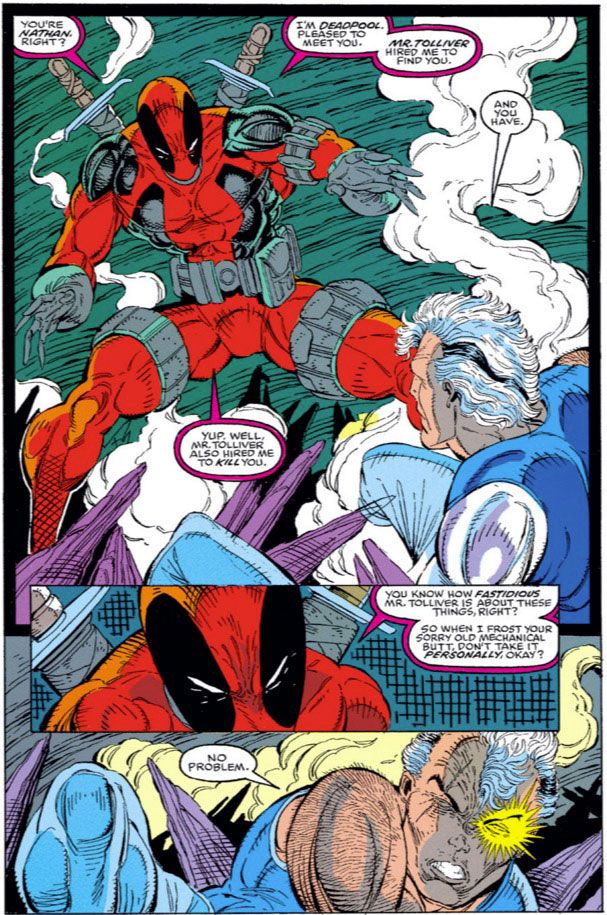
“I had a notebook full of names,” he recalls. Whenever an idea for a cool character name occurred to him, he’d jot it down and build visual and personality traits around it. He says his parents used to talk about what they called the “dead pool” — when a celebrity would die, they’d superstitiously believe two more were going to die in quick succession, and they’d place informal bets on who the next victims would be. Liefeld liked the way the term sounded and mashed the words together.
Being an artist first and foremost, he moved on to concocting an appropriately violent look. “Obviously, if you’re going to name a character Deadpool, there’s going to be some red in that costume,” he says. So he sketched out a red-and-black jumpsuit, littered with pouches for ammo. Next came the mask, a full-head cover with giant ovals around the eyes that looked suspiciously like Spider-Man’s famous design. That’s no coincidence. “The simplicity of the mask was my absolute jealousy over Spider-Man and the fact that both of my buddies, [fellow Marvel artists] Erik Larsen and Todd McFarlane, would tell me, ‘I love drawing Spider-Man. You just do an oval and two big eyes. You’re in, you’re out.’”
Spidey also loomed large in Liefeld’s conception of the next creative building block: personality. For much of Spider-Man’s early existence following his 1962 debut, he was known for being a jokester — but those days were gone. “Spider-Man in 1990 was a depressed married guy,” Liefeld accurately recalls. “The Spider-Man I grew up with would make fun of you or punch you in the face and make small cracks. That was the entire intent with Deadpool.” But even if he was going to be jokey, he couldn’t be too light. This was the ‘90s, after all — readers needed a little bite with their bark. “I specifically told Marvel, ‘He’s Spider-Man, except with guns and swords.’ The idea was, he’s a jackass.”
There was one more foundation stone every good new character needs: backstory. Liefeld wanted Deadpool’s to be rooted in failure and disgrace. He built on the longtime X-Men motif of the so-called “Weapon X program” — a black-ops government initiative that used questionable science to build supersoldiers. The gruff and iconic Wolverine was the most famous product of the program. “Weapon X, that’s a roman No. 10,” he explains. “I said, ‘I want Deadpool to be Weapon 9. Like, before they made an omelette, they broke a lot of eggs, and Deadpool is one of the eggs that they broke.’” Like Wolverine, this new figure would be able to heal rapidly and be a deadly combatant — but beyond that, he was a screw-up. Liefeld compares the concept to the setup of the 1988 comedy Twins, in which Arnold Schwarzenegger and Danny DeVito played genetically engineered brothers, one an Aryan supersoldier and the other a disgusting zhlub. If Wolverine were Schwarzenegger, Deadpool would be DeVito.
Then the concept was given its final — and crucial — addition: a voice. If the character couldn’t actually be funny, he’d be dead in the water. Up-and-coming writer Fabian Nicieza was already doing The New Mutants’ text based on Liefeld’s plots, and he relished the freedom Deadpool offered. “He got to say whatever he wanted, whenever he wanted, to anyone at anytime about anything,” Nicieza says. “No filter, less remorse. That’s liberating for a writer!”
And so the world got The New Mutants No. 98. The cover left no ambiguity that this was supposed to be the debut of a superstar. Right below the series’ title, a yellow shape resembling an explosion contained an angry scrawl screaming, “INTRODUCING THE LETHAL DEADPOOL.” This previously unseen figure stood proudly at the center of the image, chest and crotch pointing slightly outward. Deadpool was armed to the teeth: He held a smoking gun the size of his thigh, a massive knife in his other hand, and two swords crisscrossed on his back. Whoever this guy was, he meant business.
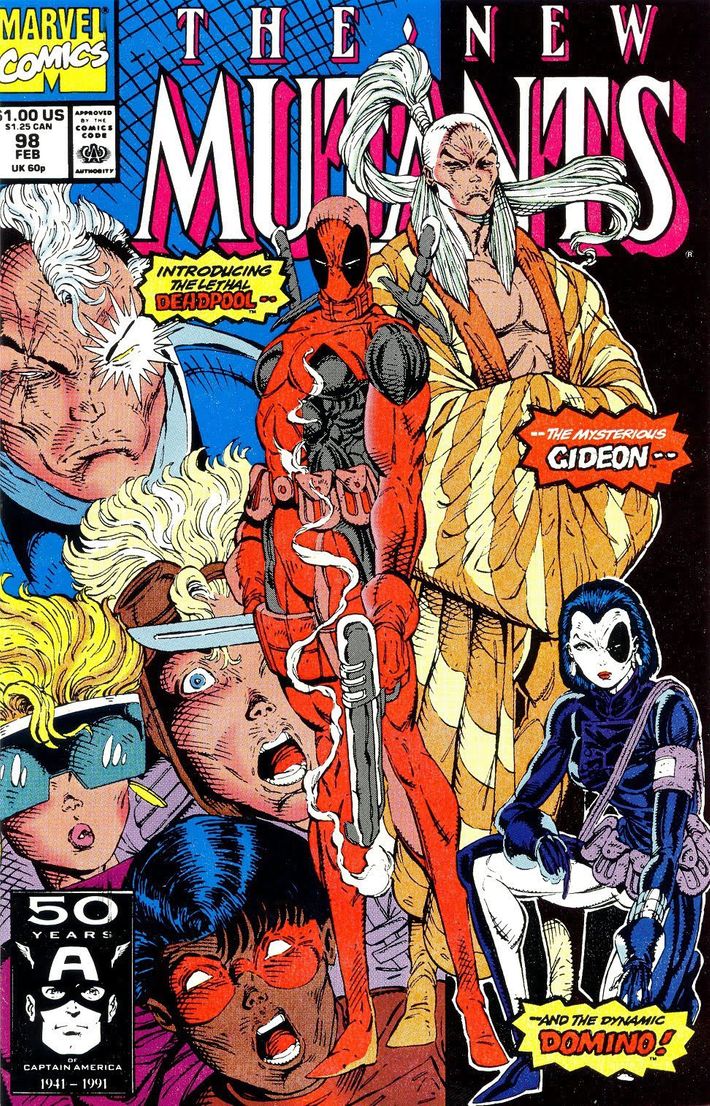
Readers were denied immediate gratification when they opened the issue, however. For 12 pages, they saw nothing of the promised Deadpool — just typical adventures and intrigue starring the titular mutant team, especially their cybernetically enhanced leader, Cable. Then, out of nowhere, Cable gets knocked on his ass. Turn the page, and you see that red-clad figure from the cover in his very first comics panel. “I’m Deadpool. Pleased to meet you,” he says, standing over his stunned prey. Deadpool explains that he’s a mercenary, hired to take Cable down. “So when I frost your sorry old mechanical butt, don’t take it personally, okay?” Five pages of vintage Liefeld tussling and Nicieza quipping followed. The character wasn’t exactly hilarious, but he was certainly funnier than the average superdude in the grim-and-gritty world of ‘90s comics. And he was an instant hit.
“New Mutants mail increased — no kidding — by about 500 percent for New Mutants No. 98,” Nicieza recalls, “and three-quarters of them said something along the lines of, ‘Deadpool was funny, bring him back.’”
The milking of a potential cash cow commenced. The New Mutants soon morphed into a rebranded series with the same characters and creative team, called X-Force, and though Deadpool wasn’t the star, he was a huge supporting presence. He started making cameos in other Marvel series. He got a commemorative trading card. Nicieza poked a little fun at Liefeld when he came up with the character’s civilian moniker. In the pages of Marvel’s rival, DC Comics, there was an existing gun-and-sword wielder with a full-face mask that accentuated his eyes named Slade Wilson, a.k.a. Deathstroke. As a cheeky homage, ‘Pool’s birth name would be Wade Wilson.
But if some of the character’s aspects were derivative, one became unique: his speech bubbles. Typically, comics feature simple white bubbles with black outlines and black text. But Deadpool’s had, oddly enough, a yellow outline. As comics-lettering technology improved in the next few years, his bubbles were entirely filled with yellow, and his words were written in a rough-edged font called Spookytooth. The idea was to convey that this guy was a little … off. “I wanted to differentiate the sound of his voice so that it would sound like 1992 Denis Leary in an echo chamber,” Nicieza says.
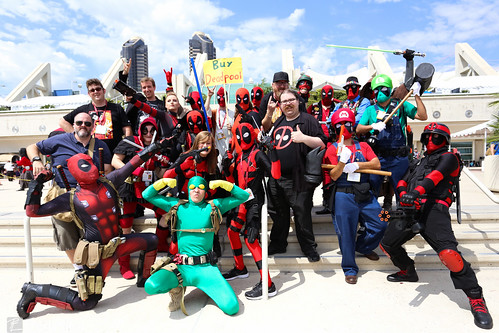
Liefeld left Marvel on nasty terms about a year after Deadpool’s debut — he and a group of other superstar Marvel artists collectively walked out on the company to form a rival publisher called Image Comics. As a result, co-creator Nicieza became the character’s steward. In the stories he wrote, we learn an abysmally tragic backstory: Wade was an ordinary human mercenary who contracted cancer and entered the Weapon X program as a last-ditch effort to get cured. The good news was the experimenters gave him a superhuman healing ability and eradicated the cancer; but they also left him horrifically disfigured and more than a little mentally unbalanced.
In 1993, Wade got his first lead role, starring in a Nicieza-penned mini-series called Deadpool: The Circle Chase. His dialogue was becoming mouthier and wackier. In the first issue, he beats up a bunch of henchmen while going off on a stream-of-consciousness pop-culture riff: “I’ve seen tougher G.I. Joes than you!” he yells while kicking someone in the face. “Come ta think of it — I’ve seen tougher Ken dolls than you! An’ I mean take yer pick here — Mod-Hair Ken —” stab “Disco Ken — Summer-Fun Ken —” punch “I-Let-Barbie-Whip-Me-’Cos-I’m-a-Wuss Ken —” elbow-slam “Any o’ you guys lissenin’ t’me?”
Then things started to fall apart. Nicieza had what he calls “a very acrimonious divorce from Deadpool” soon after The Circle Chase. He says he presented a story outline for a potential second mini-series that would see Wade’s cancer return and have him go on a rampage to take down all the assholes who’d messed up his body and face. A second mini-series did indeed happen — but Nicieza wasn’t allowed to write it. In fact, he was already clashing with the higher-ups about his work on other X-Men-related series. “The editors deemed it ‘too depressing’ — which, no kidding, of course it was depressing,” he recalls. “Let’s just say I wasn’t very happy about that decision to bounce me off the second Deadpool limited series, and it was another nail in the coffin of my involvement in the X-books at that time.”
That second mini-series, Deadpool: Sins of the Past, came out in 1994, and editor Bob Harras recruited writer Mark Waid and artist Ian Churchill to helm it. The dialogue was even poppier than previous iterations: ”I made a very conscious decision that in my mind, he was Bugs Bunny,” Waid remembers. But their reign was short-lived. Deadpool-mania had died down significantly, and Marvel wasn’t excited enough about the character to keep pushing him. He only made about a dozen appearances in any Marvel comics over the course of the following three years. One reason Deadpool was on the wane was that everything at Marvel was suffering. The publisher had financially collapsed due to an industrywide slump, and Marvel found itself in Chapter 11 bankruptcy. The leadership was in shambles, with new editors-in-chief cycling in and out every few months. But one consequence of chaos is opportunity. Amid the rubble, a new idea emerged: What if, while no one’s really minding the store, we cut the brakes and do some wild stuff with that guy with the guns and the swords?
“Deadpool was a character that, honestly, they didn’t …” Joe Kelly trails off. He’s describing Marvel’s attitude toward the character’s first ongoing series. “They really figured that he might go six issues.”
Today, Kelly is an entertainment impresario who co-owns a writers’ collective called Man of Action. But in the mid-’90s, he was a wet-behind-the-ears comics writer with virtually no experience. He got a call from Marvel editor Matt Idelson in 1996 asking him to pen a new ongoing series about Deadpool. Apparently, Matt was a fan of the character, thought Wade deserved a second chance, and got approval to go for it. It was a daunting task: Kelly had never written a monthly series before, and the property being placed in his lap had lost a lot of its shine in the wake of its co-creators’ departure. Marvel had been batting around the idea of a Deadpool series but couldn’t find a worthwhile pitch, according to Kelly. “A lot of the pitches were more focused on him as a mercenary, more slam-bang action and less of the comedy,” he recalls. Kelly, on the other hand, decided to go for broke on the laughs, both with Deadpool and his surroundings: “We were going for the most random and bizarre characters that we could come up with.” He got the gig but realized the series would need to balance its massive ridiculousness with equally massive pathos.
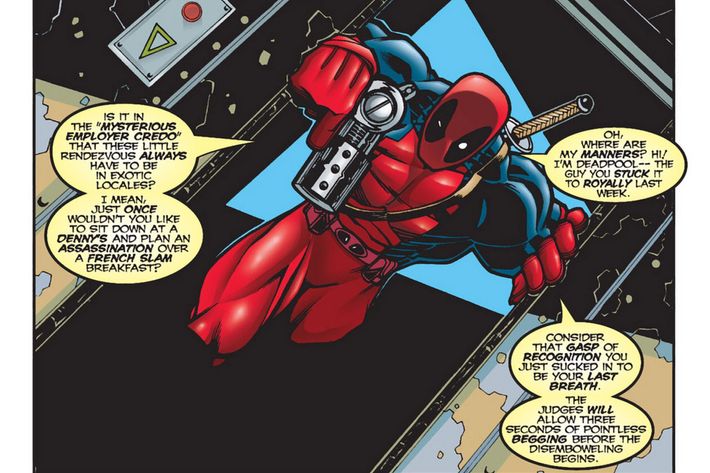
“I was like, If we’re gonna root for him, he’s gotta be somebody who wants to be good but just can’t,” Kelly says. This was a very consequential idea, as that theme has come to define the character ever since. “Deadpool is a guy who would like to do the right thing but is constitutionally incapable of pulling that off. And on those rare occasions that he does, the universe kicks him in the nuts. That was always the deal. He just cannot win.”
But he can make you laugh. Nicieza and Waid had done a fine job of making Wade Wilson a factory for zingers and put-downs, but he mostly felt like a talkative Bruce Willis — all tough-guy swagger and gallows humor. Kelly made him the Wade fans would recognize now: manic, rhythmic, childish, free-associative, and almost maddeningly unable to shut up. In other words, Deadpool became something of a murderous Robin Williams.
The first moment we see this comes in the second issue of Kelly’s Deadpool. Wade goes to the lair of the Taskmaster, a villain who can mimic the fighting style of anyone he confronts. He concocts a plan: If the baddie’s plan is to see Wade’s past moves and predict his future ones, what if he gets very, very unpredictable? Tasky cuts off Wade’s finger as a provocation and says, “Expect the mark to now explode into a rage and —”
But Wade interrupts him. “And burst into a dance number?!? I thought you’d never ask!” He starts leaping in balletic poses. “Pay attention, class, as I pass gas and knock your professor unconscious using chemical warfare — then I’m going to Macarena, because if we all just line dance, think how much better off we’d be.”
“He — he’s moving differently!” Taskmaster yells. “His technique … suddenly erratic — unpredictable — but that’s impossible!”
Wade launches into a classic Deadpool monologue, kicking and punching intermittently throughout:
Not when you use the ‘Dancing On the Ceiling’ style of kung fu taught by sensei Lionel Ritchie, or the My Left Foot style perfected by Daniel Day-Lewis! Didn’t anyone tell you? I’m a riddle, dude. I eat the uncertainty principle for breakfast. I was born the original loose cannon. And I am one unpredictable feather-pluckin’ walrus! Koo-koo-ka-freakin’-choo!
He lands a knockout punch on Taskmaster and declares, “With due respect to Alice — ‘school’s out forever.’” (He may have won this particular fight, but Wade being the luckless guy he is, he would spend the next dozen or so issues facing defeat after defeat.)
So it was from 1997 to 1999, during Joe Kelly’s run on Deadpool. It was rarely a financial hit, perpetually running into the threat of cancellation. But in hindsight, what it lacked in sales, it more than made up for in mythos- and character-building. In addition to perfecting Wade’s voice, Kelly introduced many of the core characters and settings we will see this weekend in Deadpool: the foulmouthed older woman who lives with Wade, Blind Al; the former Catholic girls’ school where Wade goes to hang out with fellow mercenaries; and Ajax, the man who tortured him during the awful days of experimentation that made Wade the disfigured horror-show he is today.
Kelly also wrote what is near-universally regarded as one of the best Deadpool stories of all time, and, indeed, one of the best superhero comics tales of the 1990s: Deadpool No. 11, in which Wade and Blind Al get shunted back in time. The conceit was that Kelly and artist Pete Woods would “Forrest Gump–ify” an old issue of Spider-Man from 1967 — for every panel, they’d painstakingly edit out Spidey and Aunt May and replace them with ‘Pool and Al, respectively. The resulting tale cemented another essential aspect of Deadpool: commentary on superhero tropes. In the Spidey mash-up, Kelly uses Wade’s cynical voice to point out how weirdly easy it is to trick heroes with red herrings, how badly written teen-pandering slang can be in comics by adults, and how strangely asexual all superhero romance is.
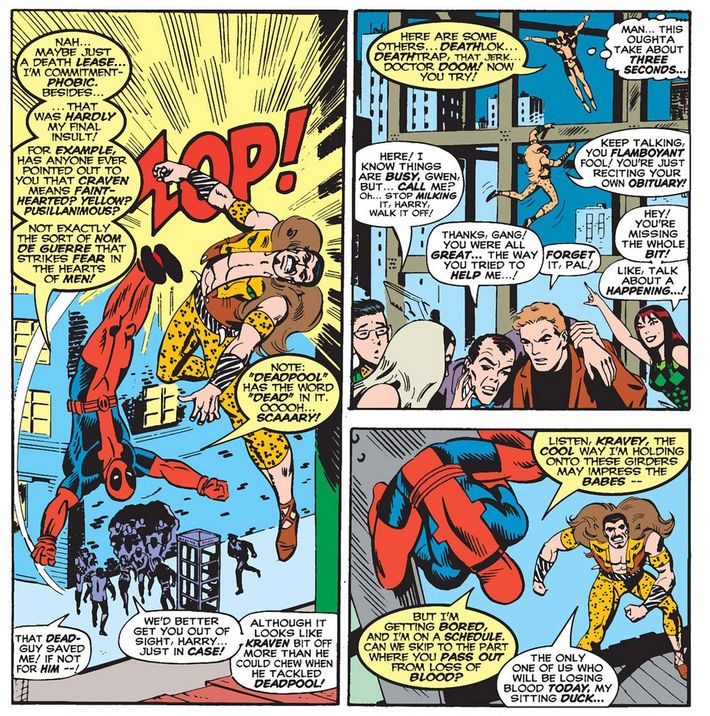
But if Kelly toyed with the reader’s suspension of disbelief, it was the writer who followed his 1999 exit from the series that really took a sledgehammer to the fourth wall. His name was Christopher Priest, and right off the bat, he decided Deadpool was going to be a comic-book character who was actually aware he was in a comic book. In Priest’s very first issue, we see Deadpool walk into a trailer park filled with other superheroes that Priest has written before. Someone tells Wade there’s a new writer on Deadpool, one who has never been assigned to a successful series. An angry Wade takes a large bag labeled “Every good idea Kelly ever had and everything that made this book work” and hauls it into an inky abyss. A few pages later, he says he’s learned a secret about the world: “None of this is actually happening. There is a man. At a typewriter. This is all his twisted imagination.” Throughout the rest of the Priest run, Deadpool would periodically address the reader, talking about the preposterousness of the stories you were reading and superhero clichés in general.
This kind of storytelling tactic in a mainstream superhero comic was unusual. But it has since become de rigueur for Deadpool, and anyone who watches the movie will experience it right away. If you go down the checklist of core Deadpool characteristics — man-child humor, clever satire, brutal violence, wacky supporting cast — they were more or less in place by the time Priest departed the series in 2000. By then, for all its stylistic virtues, it was something of a financial basket case. The series puttered along for years, with its monthly circulation at comics shops dwindling to a dismal 24,000-copy range in mid-2001. (For comparison: The top-rated X-Men series of the era was shipping about 100,000 copies a month.) There was a ray of hope in 2002, when an untested young writer named Gail Simone was brought on to take a stab at the ailing series. The results were as funny and hyperactive as the heights of the Kelly run.
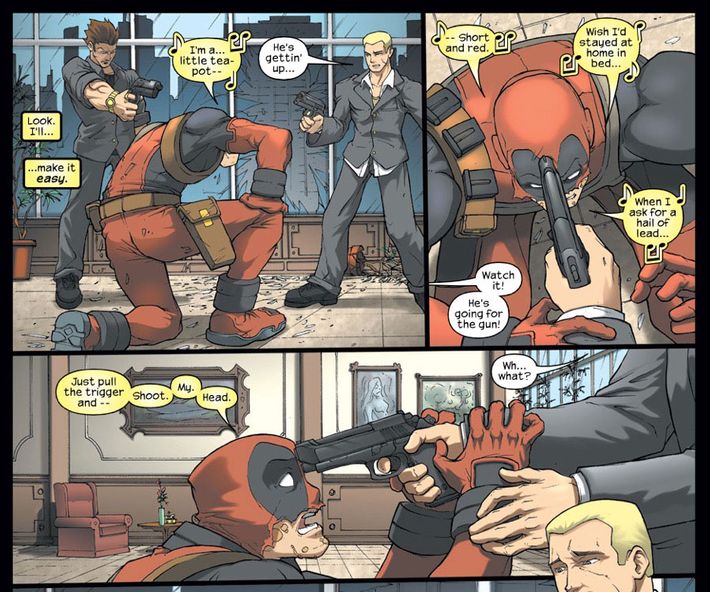
And yet, as is always true with Wade Wilson, no good deed goes unpunished. “The first issue is out and there’s all this buzz, I couldn’t be happier,” Simone says. “Then I get a call from Marvel: ‘Listen, we are so happy with what you’re doing, congratulations, and thank you, and we’re canceling the book.’” All of a sudden, Deadpool was replaced with a strange new series — also written by Simone — called Agent X. It followed the adventures of a disfigured killer with a sense of humor … who wasn’t Wade Wilson and didn’t wear a Deadpool costume. A few factors might have been at play. Marvel was in a period of transition, trying out new things with X-Men-related series, of which Deadpool was one. There was also a minor kerfuffle between Marvel and one of the character’s co-creators (Nicieza says it wasn’t him), leading Marvel to temporarily step back from the character he co-created. (Neither Liefeld nor Marvel responded to requests for comment on the matter.)
No matter the reasons, Agent X only temporarily juiced sales. Simone says a new editor on the book clashed with her over her comedy writing, and she left after issue 7. After her departure, the series went back into the 24,000-a-month range and ended after issue 15. Wade made an appearance in the final few installments, but the damage to the brand had been done. Marvel shuttered the series, and with it, any ongoing solo adventures of Deadpool. The company brought him back in 2004 for a duo series co-starring Cable called Cable & Deadpool, written by Nicieza. Though it delivered plenty of wild Wade action, it never became a hit, and consistently charted near the bottom of the top 100 comics on any given month. When the series was quietly canceled in 2008, watchers of the comics industry could reasonably assume there wasn’t much gas left in the tank for the character. No one could have predicted that the superhero world was, in fact, on the verge of total Deadpool-mania.
“The thinking was, This character has flatlined. We don’t care what you do. Just get a pulse,” writer Daniel Way says. “This was my mandate.”
Way was in his mid-30s and had been writing for Marvel since the early 2000s, and in that time, he and a hotshot Marvel editor named Axel Alonso had often discussed characters they thought were underappreciated by the market. One who always came up was Deadpool. Alonso was put in charge of Cable & Deadpool in its waning months, and he had a bold, possibly terrible idea: to break Deadpool out into his own series again and turn him up to 11. “I wanted to double down on the sophomoric, anarchic humor he’s built for,” Alonso says. “Humor was a hard sell at the time, but let’s face it, that’s Deadpool’s oxygen.” He called up Way, and told him they had the green light and he wanted him writing a brand-new monthly Deadpool.
It was a surprise smash when it debuted in 2008. The first issue placed 17th on the charts for the month, sold out, and went to a second printing. Then the third issue sold out and needed a new printing, too. And the 11th issue. Average sales in the first year were 55,194 issues a month — bigger numbers than anything Deadpool-related had seen in years. It was flying off the shelves. Something had changed. Marvel recognized that Deadpool was suddenly a hot property in a way he hadn’t been since 1992. The trouble is, to this day, no one’s exactly sure why. “Marvel was smart enough to know the book was working,” Way recalls. “They didn’t know why or how, but they knew it works, so they left me the hell alone.”
It’s entirely possible that Deadpool’s success was simply due to Way’s storytelling. His Wade was more insane than he’d ever been. Deadpool now had a pair of voices in his head talking to him near-constantly — a trope that hadn’t been a part of the character before. Way says it was part of his effort to accentuate Wade’s moral ambiguity and mental instability. “We had this internal tagline: ‘Madness is his method,’” he recalls. “Doesn’t everyone have an angel and a devil on the shoulder? That’s what I was doing, except I made them both devils. It gave him a triangulating perspective so he could see things others didn’t.”
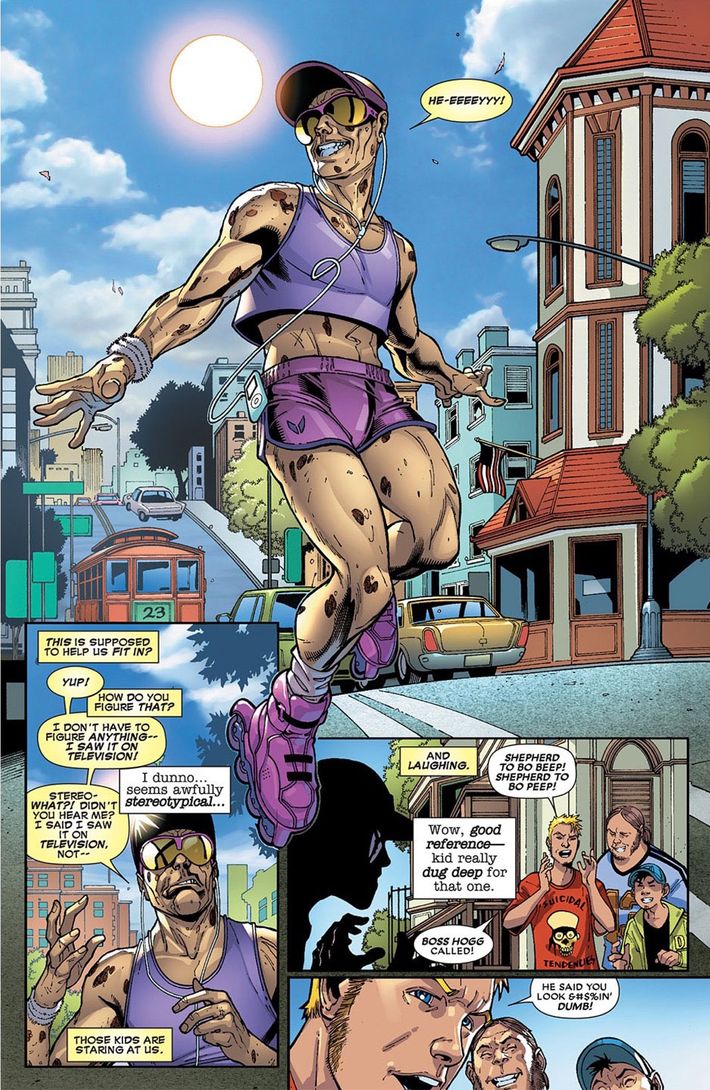
These internal conversations got very surreal. In issue 11, Wade gets shot in the skull with an arrow while running from an evil archer, leading one of the voices to become temporarily deranged. “Should’ve grabbed that cleaver! Why didn’t you think of that?” Wade yells to his own mind. “Sorry, not my department,” says one of the voices. “Ban an an an an an an an an an a,” replies the other. “Well?! What is your department?!” Wade screams to himself. “The more esoteric realms of thought,” the functioning voice replies. “For example: in mortal danger / in shadows, a psychopath / step into the light.” Wade crinkles his forehead in thought about what his own brain has just said to him. “Was that … haiku?!”
Combine that dizzying narrative play with Way’s penchant for violent action (Wade was now involved in capers with aliens and mutant sharks), irreverent self-referentiality (during a Spider-Man team-up, he shouts, “What up, baby boy! Haven’t seen you since Amazing Spider-Man No. 611!”), and frat-house humor (Wade at one point sneaks up on an enemy who thought he’d beaten him and scrawls the perennial video-game taunt “RESPAWN LOL” on a sign to insult him), and you had a heady brew of thrilling elements. Way says the key was accentuating Deadpool’s uniqueness in the superhero canon.
“Axel told me this very early on, that when you’re writing a comic-book series, a solo series, if you take that character out and plug any other character in and it still works, you haven’t written a good story,” Way muses. “With my Deadpool stories, if you take Deadpool out of it, it makes zero fucking sense.”
That uniqueness gave the character another advantage, one that’s often brought up in explanations of why he was suddenly moving sales at such a fast clip: He was well suited to the growing ecosystem of online fandom. “You could conceivably connect the rise of social media and YouTube to the rise of his popularity,” says ComicBookResources.com columnist Brett White. “His sense of humor is so referential and quick. He has no attention span. He is the internet.”
A different kind of digital medium — one far more popular than comic books — also contributed to Wade’s rise. In the 2000s, Marvel started to bet big on licensed video games based on their intellectual property, and Deadpool was a popular character in such hits as 2006’s Marvel: Ultimate Alliance, 2009’s Marvel: Ultimate Alliance 2, and 2011’s Marvel vs. Capcom 3. By 2011, any game appearance was merely contributing to the tidal wave that had already overtaken comics.
Marvel doubled down on the character in an unprecedented way. Between 2009 and 2012, there were an astounding 11 different comics series starring Deadpool. No character in comics history has been that prolific. There was a series about Deadpool traveling to parallel universes and making a team of alternate versions of himself, two adults-only noir series that allowed Wade to swear, and a hit mini-series called Deadpool Kills the Marvel Universe in which an alternate-reality Wade murders every Marvel superhero. In 2013, the main Deadpool series got relaunched with two top-shelf writers of comedy, Gerry Duggan and Brian Posehn, and their run sold like gangbusters. As industry analyst Xavier Lancel put it this past December, “Deadpool has confirmed himself as Marvel’s most lucrative cash machine.”
Thanks to his surge in comics, games, and social media, Deadpool also became a massive hit in a very lucrative corner of the superhero world: merchandising. “There’s new items coming out every week, pretty much,” says Andrew Cohen, marketing manager for New York superstore Midtown Comics. “We have more Deadpool shirts and apparel than any other character. When we go to conventions, there’s more Deadpool cosplayers than every other character.”
One such cosplayer is a 30-year-old Los Angeles man named Andy, who dresses up around the country as “DeadFNPool” and answers fan messages on his Facebook page in character. “He’s the antihero — that instantly connects with me,” he says. “I was never the school jock or the prom queen … I was the outsider. I was the joker in the classroom, the speak-and-think-later type of guy.”
Andy is far from the only person attracted to Wade’s devil-may-care attitude and man-child sense of humor. Hop on to any one of the many Facebook fan pages for the character, and you’re liable to see hundreds of likes on images of Deadpool with overlaid text saying things like “I DONT ALWAYS CELEBRATE NEW YEARS, BUT WHEN I DO, ITS WITH CHIMICHANGAS AND GANGSTA BITCHES” [sic]. Even children — perhaps especially children — are into ‘Pool. “Whenever we have kids ages 10 to 13, they’re always like, ‘Where can I get the Deadpool comics?’” Cohen says of little visitors to his store. “It worries me.”
But Deadpool fandom isn’t all fart jokes and memes. In fact, Deadpool-mania has attracted a surprising sector of superhero enthusiasts: progressives who admire him as a queer and outsider icon. Throughout the character’s publication history, there have been scattered instances of Wade making sexually and romantically charged comments about men. He once had an erotic daydream about applying lotion to a barebacked Cable. He told Thor, “I find you really attractive.” While in a hospital, he remarked, “I was dreaming of Grey’s Anatomy, McSteamy with his tousled hair assuring me the brain surgery would be successful.” There are a dozen or so homoerotic moments like this from his 25-year history, and although that may seem like a tiny number, you have to understand: This is superhero comics. Superman, Batman, and even Spider-Man would never say things like that.
Another thing setting him apart: Deadpool is a rape survivor. Back in the Joe Kelly run, a female villain took advantage of a drunk Wade and had intercourse with him while disguised as someone else — only for Wade to wake and find he’d had his consent violated by this evil trick of identity. Again, it’s not a major plot point, but in the world of mainstream superheroes, it’s extremely unusual.
“A lot of queer and minority readers seem to latch on to him,” says Li Izumi, a queer woman and maintainer of an impressively exhaustive Deadpool encyclopedia. “He’s not neurotypical” — a term referring to the fact that he struggles with mental illness — “he’s not straight, he’s a bit of an outcast. Yes, he’s had some stories where he’s very dudebro. But he’s also had a lot of issues where he’s coming to grips with depression or self-loathing.” Nicieza, Liefeld, and current series writer Gerry Duggan have all said the character isn’t purely heterosexual. (Marvel, for what it’s worth, declines to comment on Wade’s sexuality.) On the other hand, his identity can be divisive. Brett White — who identifies as gay — had a much-discussed column deriding such readings as shallow and gay-baiting, entitled “Deadpool Ain’t My Idea of Queer Representation.” But he’s still a Deadpool fan nonetheless.
The point here: A wide swath of people from an array of backgrounds and perspectives have caught Deadpool fever. His current solo series is a consistent seller, but perhaps more important, he’s the lead in a variety of mini-series that take place almost entirely outside of normal Marvel continuity. They’re self-contained romps featuring Wade doing things like fighting zombies or inserting himself into Moby-Dick and A Christmas Carol. Unlike most superhero characters, you can enjoy his stories without having to read a pile of other comics to understand the universe in which he operates. You can just pick up a trade paperback collection of one of these little side adventures — and many people do, with Deadpool accounting for a massive share of Marvel’s paperback sales — and enjoy the Merc With a Mouth undiluted by other less interesting heroes. Novices are very much welcome to join the ‘Pool party.
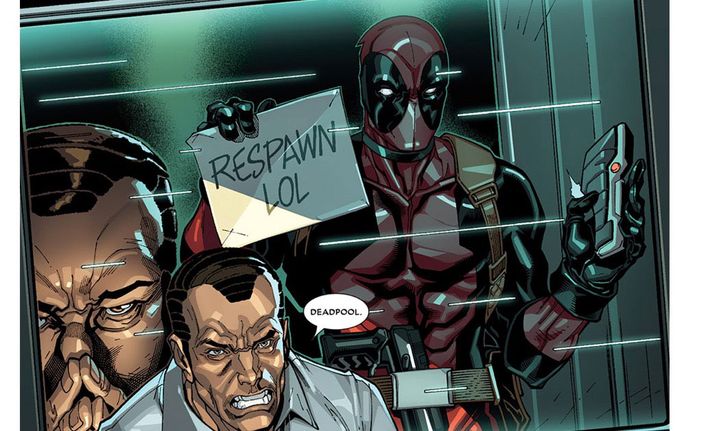
On the other hand, longtime comics obsessives also have a lot to love about Deadpool for a very specific reason: Writers use him more and more these days as a mechanism for critiquing the byzantine continuity and confusing minutiae of the genre to which they’ve devoted so many hours and dollars. Take a recent comic where Wade has a “flashback” to something that couldn’t possibly have happened in the timeline of the Marvel universe: an instance when he stole one of space dictator Thanos’s legendary-in-the-comics-world “Infinity Gems” while the ultrabaddie slept in a hammock. (The details of the incident may sound confusing to a non–comics geek, but that’s kinda the point.)
“How did that happen?” Wade asks the reader. Below his dialogue bubble, there’s a note from the editor of the comic, Jordan White: “It didn’t! What are you doing? Is that Thanos? —Jordan.” “Through the magic of the seventh Infinity Gem, that’s how,” Wade continues. “Six! There are six! —Jordan.” Wade plucks one and declares that it’s “the Continuity Gem.” Suddenly, sweaty and overweight fanboys crowd around ‘Pool, grabbing for the stone. “Editors tremble before its limitless power to retcon Marvel Comics history with but a whim!” (Retcon being a word referring to times when creators retroactively say certain things didn’t canonically happen.) White’s metatextual retort: “I’m trembling! Are you satisfied? Put that down before you break something! —Jordan.” Such metanarratives are catnip for self-hating nerds who are eager for twists on what they already love.
This broad coalition of obsessives, progressives, fratty jokesters, and casual superhero enthusiasts is unique to Deadpool — and that’s why 20th Century Fox is so confident Deadpool will be a game-changing film. But it wasn’t easy to get it made.
“It was a passion project for Ryan,” says Simon Kinberg, one of the movie’s producers. He’s talking, of course, about Ryan Reynolds, who has been pushing to star in a Deadpool flick for nearly half his career. “He was the one who first started working with the writers and developed the script, and kept championing it all those years.”
In 2000, Marvel struck a deal with Artisan Entertainment to potentially produce a slate of movies based on comic-book characters, and Deadpool was mentioned as a possible property. There wasn’t a lot of movement until Reynolds started talking with superstar screenwriter David S. Goyer (Man of Steel, Christopher Nolan’s Batman series) while the two were working on 2004’s Marvel-adaptation flop Blade: Trinity. Their plans for a Deadpool movie didn’t work out, but a seed had been planted. Reynolds “remained obsessed with the character,” according to former Fox exec Jeff Katz. “He is that character.”
The Canadian heartthrob’s dreams came partially true in 2009, when he played a version of Deadpool in that year’s X-Men prequel, X-Men Origins: Wolverine. His first two scenes were pitch-perfect Wade. We meet him as a black-ops soldier working alongside Wolverine in a time before Wolvie became an X-Man and before Wade became deformed. At one point, their squad gets briefly trapped in an elevator. “Stuck in an elevator with five guys on a high-protein diet. Dreams really do come true,” Wade whispers. The commander tells him to shut up. “Thank you, sir. You look really nice today,” Wade replies. “It’s the green. It brings out the seriousness in your eyes.” Wolverine growls at him: “God, do you ever shut up, pal?” “No,” Wade says, “not when I’m awake.” Then they get out, and Wade viciously annihilates a room full of baddies using his swords. It was something straight out of a Daniel Way or Nicieza/Liefeld issue.
If only the rest of the film had done him the same kind of justice. He disappears for most of it, only to return near the end as a genetically modified supersoldier who can teleport, shoot lasers from his eyes, and turn his hands into swords. But … his mouth is sewn shut, for some reason. The Merc With a Mouth couldn’t speak. The movie did reasonably well at the box office, but it was anathema for fans. “I heard that movie is still played as a torturing device during police interrogations,” says Andy the cosplayer.
Nevertheless, there was still hope for a big-screen Wade. Fox was enthusiastic about a Deadpool spinoff and handed the project to veteran producer Lauren Shuler Donner, who promptly reassured fans that she, too, hated the way he’d been treated, telling Empire, “We’re either going to pretend that X-Men Origins: Wolverine didn’t happen, or mock it, which [Deadpool] could do.” Zombieland screenwriters Rhett Reese and Paul Wernick were brought onboard in 2009 after their tryout script won Reynolds’s heart. A visual-effects coordinator with no feature-directing credits named Tim Miller was enlisted in 2011, and he promptly sought the blessing of Rob Liefeld, which was eagerly granted. Soon afterward, Miller invited Liefeld to watch the creation of an action-packed, gag-filled visual-effects test in which Deadpool talks to the viewer before getting the drop on some baddies in an SUV. Liefeld told everyone who would listen — fans, movie insiders — that the footage was awesome. But gradually, he was one of the only ones making any Deadpool-related noise. The project went on the back burner for years. Buzz died down. Fox devoted its efforts to first rebooting the core X-Men franchise with X-Men: First Class and The Wolverine.
Then something remarkable and mysterious happened. On July 28, 2014 — one day after the end of the San Diego Comic-Con — someone leaked a low-res version of that test footage from years before. It tore up entertainment and geek-news sites. “Deadpool Movie Test Footage Leaks, Is Perfect,” read the headline on DenOfGeek.com. Gawker site io9.com declared, “It’s so perfect it will break you[r] heart that this movie hasn’t been made yet.” Liefeld, Reese, Wernick, and Kinberg all swear they didn’t leak it and don’t know who did, but, as Kinberg puts it: “Whoever did: thank you.” Interest was reignited, and the movie’s team was suddenly taking meetings about the project again. “It showed everyone just how fervent the fans are about Deadpool, and indicated to the studio that there may be a broader audience out there,” says Kinberg. Within just a few months, Deadpoolwas green-lit, and production began.
Thanks to an astoundingly aggressive marketing campaign, the online and offline worlds have been inundated with Ryan Reynolds’s masked visage in various wacky scenarios for the better part of a year. There was the fake Extra segment on April Fool’s Day 2015, where Reynolds said the movie would be rated PG-13 — only to witness Deadpool knocking out host Mario Lopez with a stage light and announcing that the movie would be rated R. There was Reynolds’s Mother’s Day tweet with an image of ‘Pool delivering a baby and the caption, “#Deadpool: A motherfucker since 1991.” The Los Angeles billboard reading “💀💩L” (Get it? “Dead” “Poo” “L”?). The testicular-cancer-awareness video starring Reynolds in the Deadpool costume. A soccer promo in which Wade fantasizes about kissing Wayne Rooney. That’s just a small fraction of the advertising the studio has done. Fox is pretty confident about this thing.
And now we are on the verge of the apotheosis of Wade Wilson. Having seen the movie, I can say it isn’t for everyone, and a lot of the plot is conventional hero’s-journey material — but boy, it really nails the spirit of Deadpool. I’ll refrain from spoilers, but suffice it to say that Reynolds absolutely submerges himself in the character: He’s filled with man-child humor (masturbation jokes abound), never shuts up, spews constant pop-culture references, directly addresses the viewer, lampoons superhero clichés and mocks the movie’s creators, and there’s even a soupçon of guy-on-guy kissing. The movie is good, but Wade — sorry, I mean Ryan — is electric.
Deadpool is predicted to be a huge success for Fox, and they’re reportedly already working on a sequel, all but guaranteeing that the Age of Deadpool is upon us. As always, the children are our future, and at least one dad can attest that the next generation is already full of Wade Wilson addicts. Rob Liefeld says he spent years refraining from telling his kids that he co-created Deadpool but watched with awe as they got into the character anyway, thanks to video games and action figures.
“I would walk in from running errands, and my two boys and their eight friends were piled on the couches, playing Marvel vs. Capcom on the big screen, and it’s Deadpool fighting Deadpool,” Liefeld recalls. “They didn’t know that the Liefeld family had anything to do with it. They’d just say he was cool. And that was awesome. That’s just job security. Deadpool will be around for a while, and it feels good.”
